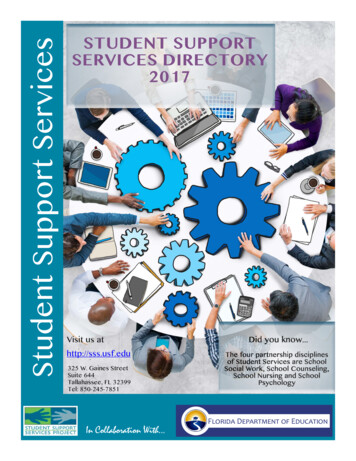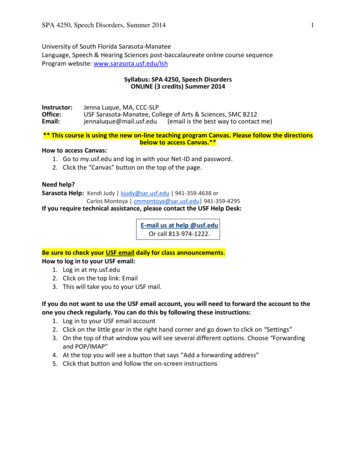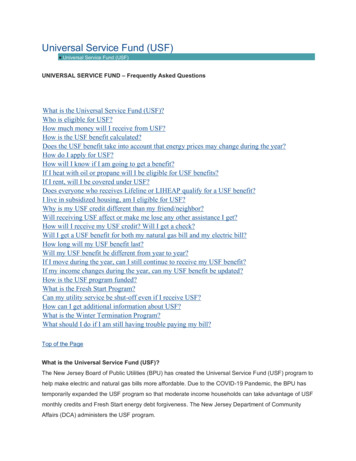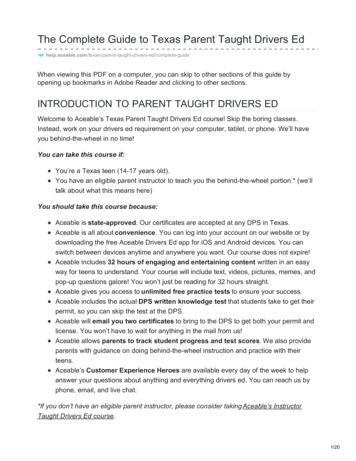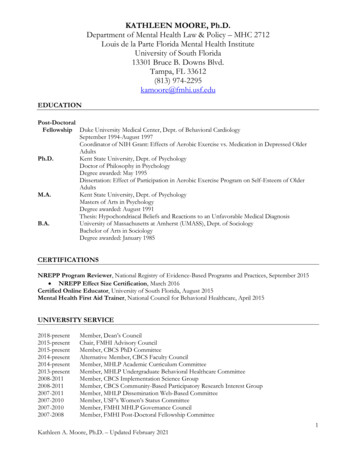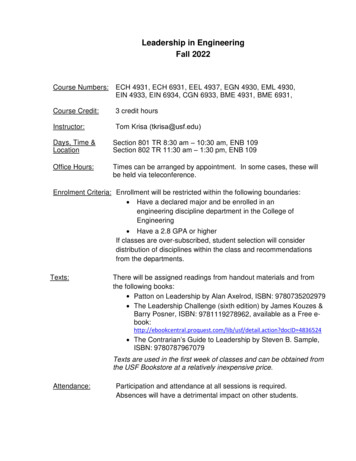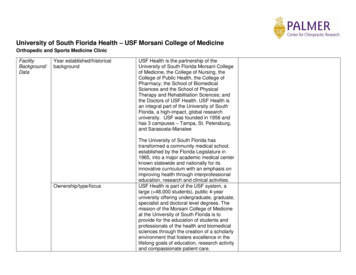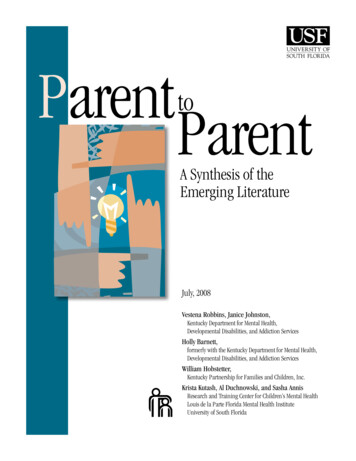
Transcription
ParenttoParentA Synthesis of theEmerging LiteratureJuly, 2008Vestena Robbins, Janice Johnston,Kentucky Department for Mental Health,Developmental Disabilities, and Addiction ServicesHolly Barnett,formerly with the Kentucky Department for Mental Health,Developmental Disabilities, and Addiction ServicesWilliam Hobstetter,Kentucky Partnership for Families and Children, Inc.Krista Kutash, Al Duchnowski, and Sasha AnnisResearch and Training Center for Children’s Mental HealthLouis de la Parte Florida Mental Health InstituteUniversity of South Florida
This publication was produced by the The School-Based Mental Health Services Study ofthe Research and Training Center for Children’s Mental Health. This study investigatesschool-mental health collaboration in the context of the overall mental health system, withspecific attention to financing methods that are consistent with implementing an effectivesystem of care, and mechanisms that ensure strong family voice at all levels of the system. July, 2008Research and Training Center for Children’s Mental HealthDept. of Child & Family Studies, Louis de la Parte Florida Mental HealthInstitute, University of South FloridaRecommended citation:Robbins, V., Johnston, J., Barnett, H., Hobstetter, W., Kutash, K., Duchnowski, A. J., & Annis, S. (2008). Parentto parent: A synthesis of the emerging literature. Tampa, FL: University of South Florida, The Louis de laParte Florida Mental Health Institute, Department of Child & Family Studies.For more informationSee the Web site http://rtckids.fmhi.usf.edu or call the Center at 813-974-4661.This document may be reproduced in whole or part without restriction provided the Research and TrainingCenter for Children’s Mental Health, Louis de la Parte Florida Mental Health Institute, University of SouthFlorida is credited for the work.The Center is jointly funded by the National Institute on Disability and Rehabilitation Research, U.SDepartment of Education and the Center for Mental Health Services, Substance Abuse and Mental HealthServices Administration under grant number H133B040024. The opinions contained in this document arethose of the authors and do not necessarily reflect those of the U.S. Department of Education or SubstanceAbuse and Mental Health Services Administration.ii Parent to Parent: A Synthesis of the Emerging Literature
ContentsParent to Parent:A Synthesis of the Emerging LiteratureIntroduction. 1Purpose. 1Method. 2Results. 2Discussion. 6Literature Review. 7Topical Discussions. 7Study 1.8Study 2.9Study 3.10Study 4.11Descriptive. 12Study 5.13Study 6.14Study 7.15Study 8.16Study 9.17Study 10.18Study 11.19Study 12.20Study 13.21Study 14.22Study 15.23Qualitative. 24Study 16.25Study 17.26Study 18.27Study 19.28Quasi-Experimental. 29Study 20.30Study 21.31Study 22.32Random Control Trial. 33Study 23.34Study 24.35Study 25.36Study 26.37Study 27.38Study 28.39Study 29.40Study 30.41Study 31.42References. 43Parent to Parent: A Synthesis of the Emerging Literature iii
Table of Contentsiv Parent to Parent: A Synthesis of the Emerging Literature
PurposeParent-to-parent programs can serve as a baseof support for parents in a multitude of situations.Most commonly, parent-to-parents programs serveparents of children with emotional and behavioraldisorders and children with physical disabilitiesor chronic health problems. Learning about theirchild’s disorder, the services available to them, andcoping with family stress can be extremely difficultfor most parents. Parent-to-parent programs offersupports to these parents by matching them withparents who understand the stress by virtue of sharedexperience (i.e., have a grown or older child with thesame or similar disorder), and can offer experiencebased advice for coping with daily demands.Parent-to-parent support is a method throughwhich parents can build self-efficacy. Bandura(1997) detailed four main sources from which individuals build self-efficacy: (1) enactive masteryexperiences (prior successful experiences), (2) vicarious experiences (learning from others), (3) verbalpersuasion (understanding from peers), and (4)physiological and affective state (stress affects self-efficacy). Parent-to-parent programs generally providesupport in each of these areas. The combination ofreferral parent and veteran parent experiences allowsthe referral parent to build strengths and expandtheir capacities and limits through enactive masteryexperiences. Connection with the veteran parentalso allows the referral parent to gain knowledge ofa norm group from which to judge their capacitiesin dealing with their child and the child’s needs.The social support provided by the veteran parentcan be considered verbal persuasion, as the veteranparent believes in the referral parent’s capacities andtells them so. Parent-to-parent support has also beendesigned to reduce parent stress, thus changing theirphysiological and affective state. Through these sup-IntroductionConsumer provided services are defined bySolomon & Draine (2001) as “services providedby consumers who are employed to deliverservices to others” (p. 21). Parent-to-parentsupport is a consumer delivered service in whichparents providing support have experientialknowledge (i.e., shared experiences) with theparent receiving support. Parents providingsupport, who are often referred to as veteranparents, have shared similar experiences withthose receiving support (referral parents) andwere previously or are currently consumersof similar services. Those utilizing consumerprovided services report high satisfactionand perceived improvement for outcomes ofsatisfaction, quality of life, and social functioning(Solomon & Draine, 2001).1portive interactions of parent-to-parent programs,parents become more self-efficacious in their interactions with their child and service providers.A large pool of information exists concerningparent support. Research on parent-to-parent support, specifically, can be difficult to uncover andvaries greatly in purpose and design. This literaturereview attempts to provide a synthesis of the emerging literature pertaining to parent-to-parent support. The purpose of this review is twofold: (1) touncover any evidence of the effectiveness of parentto-parent support; and (2) to examine the concepts,constructs, and key elements of parent-to-parentthat should be considered when designing a program (i.e., case management, training, and contactmethods).Parent to Parent: A Synthesis of the Emerging Literature 1
Chapter 1: IntroductionMethodResultsA search of literature pertaining to parent-to-parentsupport programs was conducted to examine the effectiveness of parent-to-parent support and the concepts, constructs, and key elements of peer supportthat should be considered when designing a program(i.e., case management, training, education, and parentmatching). Three search engines were utilized in thesearch: PsycINFO (EBSCO) (http://web.ebscohost.com), ERIC (http://www.eric.ed.gov), and OVID(http://ovidsp.tx.ovid.com). The literature available pertaining to parent support exceeds 10,000 articles, thusthe literature search required significant refining in order to meet the specific parent-to-parent requirementsof this review. Early attempts to refine “parent support” used the key term “peer to peer,” from which theresults were too broad. The key terms most successfulfor narrowing the databases included combinations of:social support groups, mental health, parent to parent,parent-to-parent, support group, parent, and children.A total of 31 studies uncovered met the presetcriteria for parent-to-parent support and are detailedwithin this review. For organizational purposes, thestudies were divided into five categories dependenton the research design they employed: (a) topical discussion (n 4; 13%); (b) descriptive (n 11; 35%); (c)qualitative (n 4, 13%); (d) quasi-experimental (n 3;10%); and (e) random control design (n 9; 29%).Within each category, the articles were further divided into three sub-categories based on their topic:(a) mental health (n 11; 35%), which refers to studies in which participants were parents of childrenin need of mental health services; (b) disability orchronic illness (n 18; 58%), which refers to studiesin which participants were parents of children withphysical disabilities, premature birth, and/or chronicillnesses; and (c) general parenting (n 2; 7%), whichrefers to articles that did not have a disability-specificpurpose for parent support. Furthermore, the studiesare organized throughout the review using the samecategorization system, additionally arranging themin alphabetical and then chronological order withinthe sub-categories. For ease of access within the document, a complete organizational dissection of thestudies within this review, including the author, year,and study number, is located in Table 1.Using the aforementioned key words, theoriginal pool of information on parent supportwas narrowed to approximately 5000 articles andbook chapters. These remaining studies were thenreviewed by staff to determine inclusion in thisdocument. Due to the family movement that occurred in the late 1980s and early 1990s, this reviewfocused on studies published during or after 1990.Studies were further excluded if they were dissertations or were employed with designs that did notexamine parents receiving support from parents whohad shared similar experiences. Studies examiningparent-to-parent support, from the level of a singleprogram to a survey of programs nationwide, wereaccepted for review.2 Parent to Parent: A Synthesis of the Emerging LiteratureEach of the thirty-one studies uncovered in thisreview was summarized, and available data were recorded pertaining to population studied and samplesize, intervention and study purpose, definition andkey elements of support, study design and methodology, measurement and instrumentation, and results and conclusions (with the exception of three ofthe topical discussions, which provided informationbased on the topic, discussion purpose, and definition and key elements of support). These study summaries can be found in the Literature Review sectionat the end of this document.
Chapter 1: IntroductionTable 1: Study OrganizationTopicType of StudyTopicalDiscussionGeneralParentingDisability/ IllnessMental IllnessIreys, 1998 (1)DescriptiveAdams, 2006 (5)QualitativeQuasiExperimentalSlowik, 2004 (16)Random ControlTrialEliot, 1998 (23)Hoagwood, 2008 (6)Ireys, 2006 (24)Koroloff, 1991 (7)Rhodes, 2008 (25)Santelli, 1995 (8)aSantelli, 1993 (9)Hartman, 1992 (2)Vandereycken, 2005 (10)Baum, 2004 (11)Ainbinder, 1998 (17)Ireys, 2001 (20)Ireys, 2001 (26)Santelli, 1997 (3)Foreman, 2005 (12)Kerr, 2000 (18)Palit, 2006 (21)Ireys, 1996 (27)Ireys, 2001 (13)Konrad, 2007 (19)Roman, 2005 (22)Preyde, 2003 (28)Santelli, 2000 (14)Silver, 1997 (29)Santelli, 1996 (15)Singer, 1999 (30)Hogan, 2002 (4)Kottman, 1993 (31)a Study covers the combined topics of mental, emotional, and disability problems.The Definition and Key Elements of Parent to Parent SupportThe concept of parent support was the focus in every study; however, only 26 of the 31 studies provideda definition of parent-to-parent support. These definitions were inconsistent in their depth and detail acrossstudies and can be easily compared by viewing Table 2.Likewise, the constructs of parent support were inconsistently described across studies, ranging from genericexplanations of veteran parents (those with sharedsimilar experiences) to intricate details of parent training and supervision. A general consensus existed acrossstudies, though, that parent-to-parent support includesparents coping with children with a variety of problems(e.g., mental health and chronic illness) and parentswho have shared a similar experience and can offer support in various forms.of support are informed of the group’s existence andattend the offered meetings at their choosing. Otherparent-to-parent programs have firmer guidelines,placing responsibility on the veteran parent to provide support to the parent in need. For example,Ireys et al. (2001) designed a program wherein thesupporting parents made a specified number ofvisits to the family, contacted the parents at leastbiweekly, and participated in special events with thefamilies. In consideration of the difference in the keyelements of parent-to-parent programs, it is important to note that each program is designed with theintention of meeting the needs of the parent participants and that some level of modification is expectedacross studies.Key elements of parent-to-parent programswere not only inconsistently detailed across studies,but extremely varied within those studies reporting them. In parent-to-parent support programssuch as the one conducted by Foreman, Willis, &Goodenough (2005), parents who might be in needParent to Parent: A Synthesis of the Emerging Literature 3
Chapter 1: IntroductionTable 2. Parent-to-parent definitions of support across twenty-six studiesMental HealthTopicSource bDefinition of SupportIreys, DeVet, & Sakwa(1998) (1)Social support is defined as information leading people to believe they are esteemedand valued and that they belong to a network of mutual obligationsAdams, Westmoreland,Edwards, & Adams (2006)(5)Connections with parents who have had similar experiences.Koroloff & Friesen (1991)(7)Support includes a combination of functions (information, parent-to-parentsupport, advocacy), and may be formally constituted, affiliated with larger formalorganizations, or simply informal meetings with less participants.Santelli, Turnbull, Marquis,& Lerner (1995) (8)“Parent to parent programs provide emotional and informational support to parentsof children with special needs by matching a trained veteran parent in a one-to-onerelationship with a parent newly referred to the program.”Santelli, Turnbull, Marquis,& Lerner (1993) (9)Parent-to-parent programs provide emotional and informational support throughone-to-one matches. This support is more informal, flexible, spontaneous, andindividualized than the support that is generated in group settings.Vandereycken & Louwies(2005) (10)Parents provided support to parents with whom they’ve shared a similar experience(specifically, raising a child with an eating disorder).Slowik, Willson, & Loh,(2004) (16)Parent support groups offer the opportunity for problem sharing and containment ofanxiety through a psychosocial network.Ireys & Sakwa (2006) (24)“Information leading people to believe they are esteemed and valued and that theybelong to a network of mutual obligations.”Rhodes, Bailee, Brown, &Madden (2008) (25)“Parent-to-parent consultations offered families an intense emotional experiencewhich empowered them with the hope to believe that they too could achieve thegoal of recovery.”b For ease of access within the document, the author, year, and study number are listed.4 Parent to Parent: A Synthesis of the Emerging Literature
GeneralParentingDisability/IllnessTopicSource bDefinition of SupportHartman, Radin &McConnell (1992) (2)“Peer support provides benefits of experiential learning and helps to connect familieswith each other. “Santelli, Turnbull, Marquis,& Lerner (1997) (3)Programs help parents who have children with special needs find each other andbecome reliable allies for each other. They provide parents with the opportunity toconnect with and support each other through informational and emotional support,and through reciprocity.Baum (2004) (11)Parent-to-parent support mediated by computers.Foreman, Willis, &Goodenough (2005) (12)To provide parents with an opportunity to access information relevant to their child’streatment and living with a life-threatening illness, as well as to meet other parents insimilar situations.Ireys, Chernoff, Stein,DeVet, & Silver (2001) (13)“Information leading people to believe they are esteemed and valued and thatthey belong to a network of mutual obligations.” Includes further descriptions ofinformational, emotional, and affirmational supports.Santelli, Turnbull, Marquis,& Lerner (2000) (14)“Parent-to-parent programs provide emotional and informational support toparents of children who have special needs. New parents are helped to interpret andunderstand the system and to find the best possible services for their young childrenwith special needs.”Santelli, Turnbull,Sergeant, Lerner, &Marquis (1996) (15)Programs match referred parents with a veteran parent who develops a one-to-onerelationship in which the parents arrange their own supportive interactions, includinginformational and emotional supports.Ainbinder, Blanchard,Singer, Sullivan, Powers,Marquis, & Santelli. (1998)(17)Support from similar others.Konrad (2007) (19)“Veteran parents can provide parents of newly diagnosed children with personaland practical recommendations for managing and adapting to unexpected lifecircumstances.”Ireys & DeVet (2001) (20)“Information leading people to believe that they are esteemed and valued and thatthey belong to a network of mutual obligations.”Palit & Chatterjee (2006)(21)“Support services for parents of disabled students in which support is provided by ateam of volunteer parents who themselves have children with disabilities. Supportaims to reduce stress, insecurity, and helplessness, and to develop motivational level,patience, and tolerance.”Roman, Lindsay, Boger,DeWys, Beaumont, Jones,& Haas (1995) (22)Veteran parent support as adapted for the NICU was defined as emotional,informational, and appraisal support provided by an experienced, volunteer parent ofa preterm infant to a parent of a preterm infant for the purpose of increasing parents’environmental resources.Ireys, Chernoff, DeVet, &Kim (2001) (26)“Information leading people to believe that they are esteemed and valued and thatthey belong to a network of mutual obligations.”Ireys, Sills, Kolodner, &Walsh (1996) (27)The program focused on enhancing three types of social support, informationalsupport (sharing information about services, practical tips for dealing with teachersand health providers), affirmational support (praising the mother’s parenting andidentifying their competencies an providing positive feedback), and emotionalsupport (listening to mothers’ concerns, demonstrating continued interest inexperiences, and communicating an understanding of feelings and concerns.Preyde & Ardal (2003) (38)A connection with a parent who has shared experiential knowledge.Silver, Ireys, Bauman, &Stein (1997) (29)“To improve the mother’s psychological status by increasing her social support andaccess to relevant information, services, and knowledgeable advisors To makemothers feel more empowered and active participants in their children’s healthcare To discuss specific issues related to the child’s health condition, and attempt toidentify and address the needs and concerns of other family members as well.”Hogan, Linden, & Najarian(2002) (31)An exchange between providers and recipients that provides emotional (verbal andnonverbal communication of caring and concern), informational (the provision ofinformation used to guide or advise), and instrumental (the provision of materialgoods, such as money, transportation, and physical assistance) support.Parent to Parent: A Synthesis of the Emerging Literature 5
Chapter 1: IntroductionDiscussionSince parent-to-parent programs were first initiated in the early 70s, this important resource forfamilies with children who have disabilities can nowbe found operating in most communities thoughtthe country. There is however, great diversity in thenature of the programs and in the settings in whichthey are offered (Hoagwood et al., 2007; Santelli etal., 1993). For example, some parent-to-parent organizations are limited to offering resources and information to parents, while others offer peer-to-peeremotional and informational support. In the case offamilies of children who have mental health needs, arecent national survey of family organizations foundthat education, advocacy, and peer-to-peer supportare primary roles for families (Hoagwood et al.,2007).The purpose of this literature review was to examine the empirical evidence for parent-to-parent support programs and to identify the major concepts,constructs and key elements of these programs. Asa result of our review, it is clear that while literallythousands of articles have been written about parentto parent support, there are very few rigorous studiesevaluating its effectiveness. At the conceptual level,we found very little consistency in the definition ofparent support, the key elements of the programswere inconsistently detailed across articles, and thenature of the outcomes studied varied.Only nine rigorous studies were uncovered andonly three of these were conducted in the mentalhealth area including one study focusing on parentof youth with eating disorders. When consideredas a group, these nine studies primarily focused onthe impact of parent to parent support on the emotional functioning of parents (anxiety, depression,anger, or inadequate coping skills) with seven studies6 Parent to Parent: A Synthesis of the Emerging Literaturefindings positive results with parents who had theseproblems. Further, two studies explored level of empowerment of family members with one study finding positive results and the other finding no changesin empowerment levels. Finally, only one studyexamined service use with positive indications thatparent-to-parent support increases service initiationbut these effects did not sustain over time.The results from descriptive and qualitative studies were unanimous in their documentation thatparents found parent-to-parent support programshelpful and valuable. A national survey of familymental health organizations confirms that over 90%of respondents reported that providing peer-topeer support is one of the most important roles forfamilies and 85% of family mental health organizations surveyed reported providing parent-to- parentsupport.In conclusion, while the empirical base forparent-to-parent support is limited, the results fromthe studies reviewed are encouraging. It appears thatparent-to-parent support programs are valued byparents and may improve emotional functioning ofparents who have children with disabilities and helpthem improve their coping skills. The review alsorevealed that the parent to parent support field is inneed of conceptual and theoretical refinement. Thisstep is critical in advancing our knowledge of themechanisms and drivers of effective parent to parentsupport that will produce improved emotional functioning of families and increase access to services,better partnerships with providers, and ultimatelyimproved outcomes for children.
Chapter 2: Literature ReviewLiterature Review2Topical DiscussionsMental Health1.Ireys, H. T., DeVet, K. A., & Sakwa, D. (1998).Family support and education. In M.H. Epstein, K. Kutash, &A.J. Duchnowski (Eds.), Outcomes for Children and Youth with Emotional Disorders and their Families: Programs andEvaluation Best Practices (pp. 154-175). Austin, TX: Pro-Ed.Disability & Illness:2.Hartman, A. F., Radin, M. B., & McConnell, B. (1992). Parent-to-parent support: A critical component of healthcare services for families. Issues in Comprehensive Pediatric Nursing, 15, 55-67.3.Santelli, B., Turnbull, A., Marquis, J., & Lerner, E. (1997). Parent-to-parent programs: A resource for parents andprofessionals. Journal of Early Intervention, 21(1), 73-83.General Parenting:4.Hogan, B. E., Linden, W., & Najarian, B. (2002). Social support interventions: Do they work? Clinical PsychologyReview, 22, 381-440.Parent to Parent: A Synthesis of the Emerging Literature 7
Chapter 2: Literature ReviewStudy 1ReferenceTopical Discussion – Journal ArticleIreys, H. T., DeVet, K. A., & Sakwa, D. (1998).Family support and education. In M.H. Epstein, K. Kutash,& A.J. Duchnowski (Eds.), Outcomes for Children and Youth with Emotional Disorders and their Families:Programs and Evaluation Best Practices (pp. 154-175). Austin, TX: Pro-Ed.TopicDiscussionPurposeResults &ImplicationsThe family support program Family Connections.To describe 5 conceptual areas commonly underlying parent support programs.1. Effects of social support – defined as information leading people to believe they are esteemedand valued and that they belong to a network of mutual obligations. Experienced individuals(veteran parents, mentors, etc.) bring new resources – information, genuine empathy, new orrenewed sense of community, practical connections to services
book chapters. These remaining studies were then reviewed by staff to determine inclusion in this document. Due to the family movement that oc-curred in the late 1980s and early 1990s, this review focused on studies published during or after 1990. Studies were further excluded if they were disserta-tions or were employed with designs that did not
